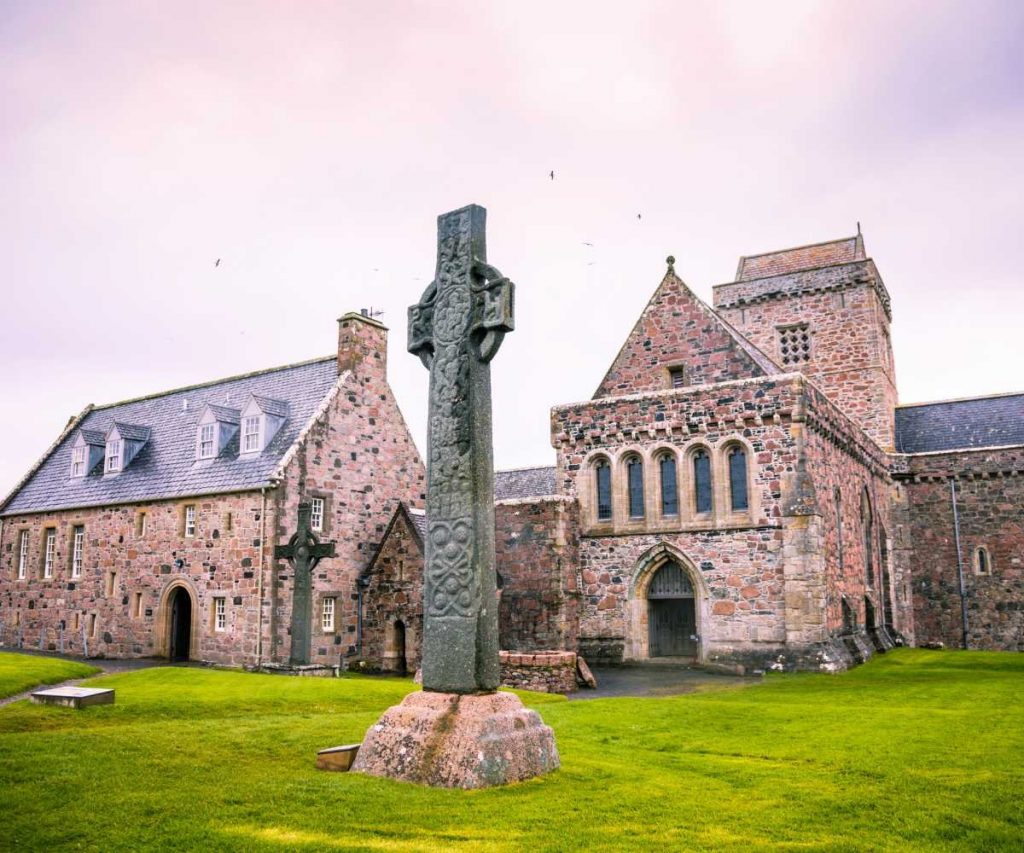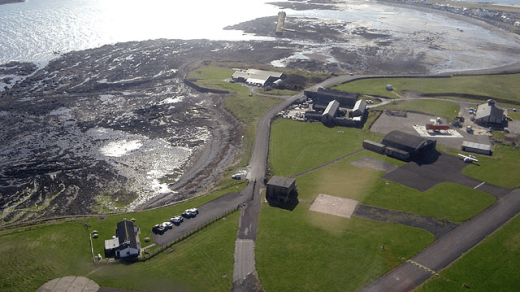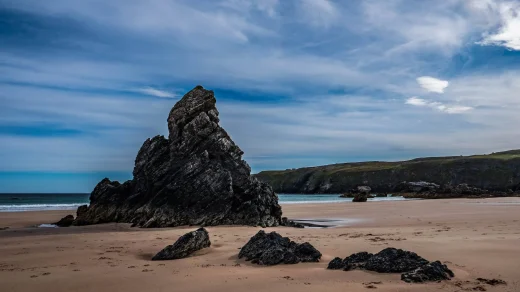Iona Abbey is an abbey located on the island of Iona, just off the Isle of Mull on the West Coast of Scotland.
It is one of the oldest Christian religious centres in Western Europe. The abbey was a focal point for the spread of Christianity throughout Scotland and marks the foundation of a monastic community by St. Columba when Iona was part of the Kingdom of Dál Riata. Saint Aidan served as a monk at Iona, before helping to re-establish Christianity in Northumberland, on the island of Lindisfarne
Iona Abbey is the spiritual home of the Iona Community, an ecumenical Christian religious order, whose headquarters are in Glasgow. The Abbey remains a popular site of Christian pilgrimage today.
In 563, Columba came to Iona from Ireland with twelve companions and founded a monastery. It developed as an influential centre for the spread of Christianity among the Picts and Scots.
The prime purpose of the monastery was to create ‘a perfect monastery as an image of the heavenly city of Jerusalem’ – Columba wanted to ‘represent the pinnacle of Christian virtues, as an example for others to emulate’ – rather than explicitly missionary activity. The monks worshipped and worked daily, following Celtic Christianity practices and disciplines. They also managed assets and were involved with the local and wider community.

Like other Celtic Christian monasteries, Columba’s monastery would have been made up of a number of wattle and timber, or wood and thatch, buildings. These would have included a central church or oratory, the common refectory or kitchen, the library or scriptorium, monk cells or dormitories, and a guest house for visitors including pilgrims. It is believed that around 800AD the original wooden chapel was replaced by a stone chapel.
Columba’s monastery was surrounded by a ditch and earth bank, part of which is believed to have pre-existed Columba’s arrival, and part of which can still be seen to the north-west of the current abbey buildings.
Adomnán describes a building on a small mound, Torr an Aba, in the monastery grounds where St Columba worked and wrote. Charred wood has been dated from what is believed to be this site, and a socket to hold a cross (which is believed to have been erected later) is visible there.
The production of Christian manuscripts, books and annals was an important activity in the Iona monastery. The Chronicle of Ireland was produced at Iona until about 740. The Book of Kells, an illuminated manuscript, is believed to have been produced by the monks of Iona in the years leading up to 800.
Stone crosses, both standing and lying, were used to mark graves in the Iona monastery. Large stone crosses were also erected, perhaps to broadcast key Christian messages, particularly in 800-1000. Their design reflected precious metal crosses. Some were carved from stone imported 50 miles by boat from Loch Sween.
Remains of wood-turning and metal-working have been found at Iona, and of glass (windows and beads) that may date from the 600’s.
The Iona monastery’s position in what was then a well-used seaway would have facilitated trade, as would St Columba’s personal aristocratic background. Pigments from the south of France were used in Iona.
The building at Kells took from 807 until the consecration of the church in 814. In 814, Cellach, Abbot of Iona, retired to Kells, but, contrary to what is sometimes claimed, it is clear from the Annals that Iona remained the main Columban house for several decades, despite the danger of Viking raids.
In 825, St Blathmac and those monks who remained with him at Iona were martyred in a Viking raid, and the Abbey was burned. But only in 878 were the main relics, with Columba’s reliquary shrine specified in the records, moved to Ireland, with Kells becoming the new main Columban house. Though not mentioned, this might well have been when the Book of Kells came to Kells. However, Iona Abbey was probably not deserted as its continued importance is shown by the death there in 980 of Amlaíb Cuarán, a retired King of Dublin.
St Columba established several monasteries, although he was mainly based at Iona.
Other monks from Iona moved to the Continent and established monasteries in Belgium, France, and Switzerland.
In 1114 Iona was seized by the King of Norway, who held it for fifty years before Somerled recaptured it, and invited renewed Irish involvement in 1164: this led to the construction of the central part of the cathedral. Ranald, Somerled’s son, now the ‘Lord of the Isles’, in 1203 invited the Benedictine order to establish a new monastery, and an Augustinian Nunnery, on the Columban Monastery’s foundations. Building work began on the new abbey church, on the site of Columba’s original church. The following year, in 1204, the site was raided by a force led by two Irish bishops. This was a response by Ireland’s Columban clergy to the loss of its connections and influence at this significant site founded by St Columba
The Iona Nunnery, a foundation of the Augustinian Order (one of only two in Scotland – the other is in Perth), was established south of the abbey buildings. Graves of some of the early nuns remain, including that of a remarkable prioress, Anna Maclean, who died in 1543. Clearly visible under her outer robe is the rochet, a pleated surplice denoting the Augustinian Order. The nunnery buildings were rebuilt in the fifteenth century and fell into disrepair after the Reformation.
The abbey church was substantially expanded in the fifteenth century, but following the Scottish Reformation, Iona along with numerous other abbeys throughout the British Isles were dismantled, and abandoned, their monks and libraries dispersed.
In 1899 the Duke of Argyll transferred ownership of the ruined remains of the Abbey and Nunnery sites to the Iona Cathedral Trust, which undertook an extensive restoration of the Abbey church. In 1938, the inspiration of Reverend George MacLeod led a group which rebuilt the abbey and founded the Iona Community. The reconstruction was organised by the architect Ian Gordon Lindsay having generously been passed the project from his senior mentor and friend Reginald Fairlie. The surrounding buildings were also reconstructed during the 20th century by the Iona Community. This ecumenical Christian community continues to use the site to this day.
The simple square font was added in 1908 and dedicated to the memory of the Very Rev Theodore Marshall DD, Moderator of the General Assembly of the Church of Scotland in that year.
In 2000 the Iona Cathedral Trust handed over the care of the Abbey, Nunnery, and associated sites to Historic Scotland.
Many early Scottish kings (said to be 48 in total), as well as kings from Ireland, Norway and France, are said to be buried in the Abbey graveyard. However, modern scholars are sceptical of such claims, which were likely mythic associated with increasing the prestige of Iona. Numerous leading Hebrideans, such as various Lords of the Isles and other prominent members of West Highland clans, were buried on Iona, including several early MacLeod chiefs. The site was much loved by John Smith, a 20th-century leader of the Labour Party, who was buried on Iona after his death in 1994.
Several high crosses are found on the island of Iona. St Martin’s Cross (dated to the 8th century) still stands by the roadside. A replica of St John’s Cross is found by the doorway of the Abbey. The restored original is located in the Infirmary Museum at the rear of the abbey.
The contemporary Jedburgh-based sculptor Christopher Hall worked for many years on carvings on the cloisters of the abbey, which represent birds, flora and fauna native to the island. He also was commissioned to carve John Smith’s gravestone.




That is indeed a lot of history. We are so fortunate to have seen the Book of Kells twice in Trinity College in Dublin. Hope all is well William. Allan
brilliant mate, good stuff, thanks for stopping by Allan, stay safe.
Thanks for this post. I have always wanted to go to Iona. Something mystical there pulls me. A friend of mine went there, and brought me back a pebble. I cherish it.
awe thanks Susan it is beautiful x
This website has quickly become my go-to source for [topic]. The content is consistently top-notch, covering diverse angles with clarity and expertise. I’m constantly recommending it to colleagues and friends. Keep inspiring us!